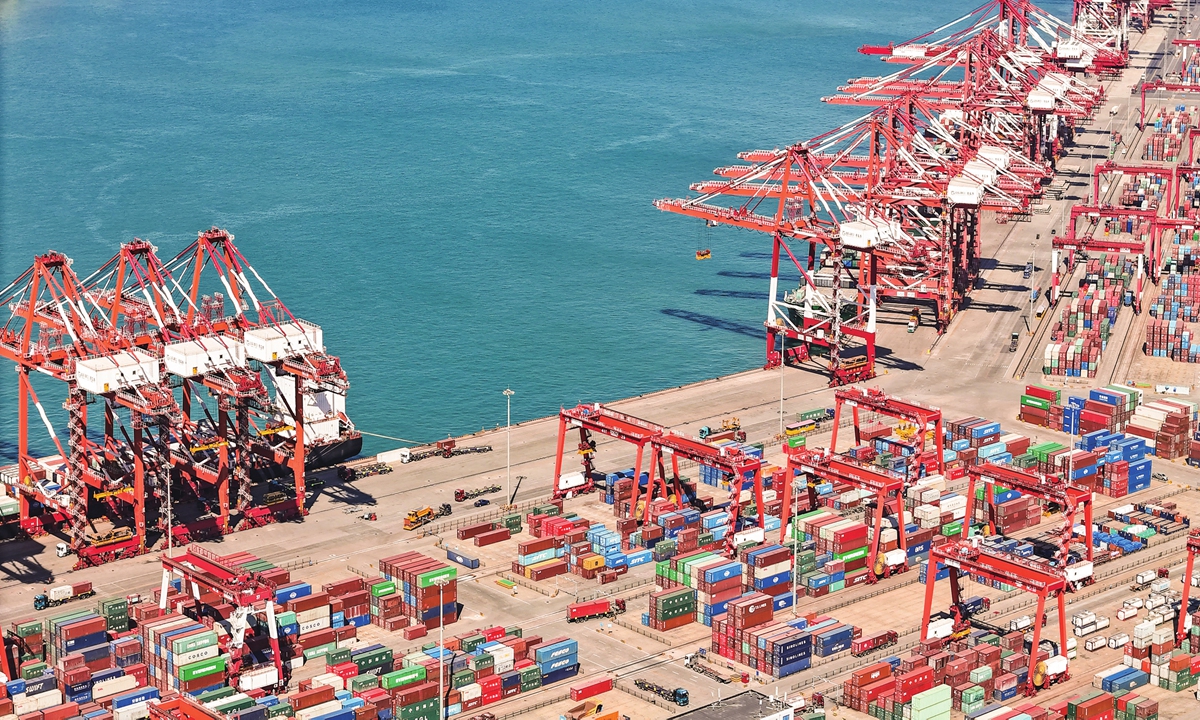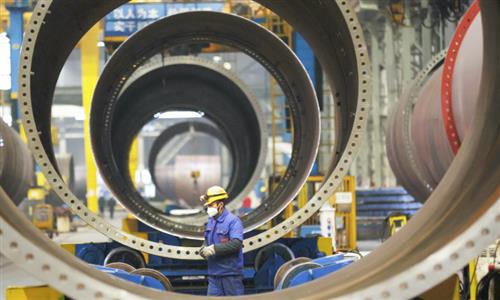

A bustling scene at the port of Qingdao in East China's Shandong Province Photo: VCG
In 2023, China's foreign trade remained stable amid a complex and challenging global environment. Contributing positively to the smooth functioning of the macro economy, the structure of China's foreign trade has continuously improved, as the sector is set to gain new momentum.In 2024, the global economic and trade environment is likely to remain challenging, with China's foreign trade growth facing a number of pressures. Supported by a range of government policies, favorable factors are converging to facilitate the high-quality advancement of foreign commerce. Looking to the future, the positive trajectory of China's foreign trade remains unaltered.
In 2023, China's foreign trade hit a new high. The yuan-denominated trade volume reached a new record of 41.76 trillion yuan, marking a 0.2 percent increase year-on-year and a 30 percent rise compared with the pre-COVID levels in 2019. In the face of sluggish global trade, China's goods trade has reached a new high for the seventh consecutive year since 2016.
Although in US dollar terms, China's foreign trade was $5.94 trillion, down 5 percent year-on-year, it still surpassed the global average growth and other major economies.
The stability of China's foreign trade relative to the global market persists. China's export market share in the first three quarters of 2023 was recorded at 14.17 percent, consistent with 2022 levels. Exports serve as a direct indicator of a nation's competitive advantage in foreign trade. The country's consistent market share underscores the strong competitiveness of China's foreign trade sector.
The number of entities engaged in foreign trade in China reached a new high in 2023, totaling 600,000 for the first time. Among them, 556,000 are private enterprises, with their trade reaching 22.36 trillion yuan, marking a 6.3 percent year-on-year growth.
The structure of China's foreign trade continues to be optimized, with the export share of China's electromechanical products reaching 58.5 percent in 2023, an increase of 1.4 percentage points compared with the previous year.
Also, new products represented by the so-called "new three items" have showcased a rapid increase in export growth, with the export growth rate of these items reaching 30 percent. In 2023, China exported 5.22 million automobiles, marking a 57.4 percent year-on-year increase. For the first time, China has become the world's largest auto exporter. Notably, exports of new-energy vehicles reached 1.77 million, reflecting a remarkable 67.1 percent increase.
In 2024, the global trade environment is likely to become increasingly complex. China's stable growth in foreign trade is facing multiple challenges, including a lackluster global economy, increasingly fragmented global trade, more trade barriers erected by some countries, and the spillover effects of geopolitical conflicts.
However, the favorable factors supporting China's long-term positive growth in foreign trade have not changed. Favorable factors supporting the high-quality development of China's foreign trade will continue to accumulate, and the long-term positive trend of China's foreign trade will not change.
First, the outlook of China's economic growth remains positive. In January, the IMF predicted that China's economy will grow by 4.6 percent in 2024, an increase of 0.4 percentage points from the forecast in October. This indicates a positive signal from international institutions that are optimistic about the continued recovery and improvement of China's economy. The stable growth of the Chinese economy has laid a solid foundation for the long-term positive development of China's foreign trade.
Second, China's advantage of having an enormous market has not changed. China has the largest middle-income group in the world. The contribution of consumption to China's economy in 2023 reached 82.5 percent in 2023. In 2023, China imported over 5 trillion yuan worth of bulk commodities, about 3 trillion yuan worth of electronic components, and about 2 trillion yuan worth of consumer goods throughout the year, making it the world's largest import market for agricultural products and intermediate goods.
Third, China's competitive edge in manufacturing has not changed. The value added of China's manufacturing industry accounts for approximately 30 percent of the global total, ranking first globally for 14 consecutive years. As the only country in the world that possesses all industrial categories in the United Nations industrial classification, China has a strong manufacturing capability and a complete industrial supply chain system.
With the continuous growth of strategic emerging industries, such as electric vehicles, lithium batteries, and photovoltaics, innovation in China's comprehensive manufacturing industry will only accelerate. This robust manufacturing industry system will further support the stable growth of China's foreign trade.
Fourth, China's business environment favoring innovation has not changed. China is implementing the strategy of innovation-driven development, continuously strengthening the protection of intellectual property rights, and creating a favorable environment for innovation. According to data from the World Intellectual Property Organization, China's ranking in global innovation index has risen from 29th place in 2011 to 12th place in 2023.
China adheres to equal protection of intellectual property rights for domestic and foreign-funded enterprises, and always cracks down on infringement of intellectual property rights. An innovative business environment favoring innovation will attract more overseas companies to come to invest in China, expanding the number of foreign trade entities.
Fifth, the determination of China to expand high-level opening-up has not changed. In 2023, which marks the 45th anniversary of China's reform and opening-up, China continues to enhance its level of openness, further optimizing the environment for foreign trade development.
China's efforts in constructing a high-standard global network of free trade zones have achieved more tangible results. Currently, China has signed 22 free trade agreements with 29 countries and regions, with negotiations on China-Gulf Cooperation Council, China-Japan-Korea, and China-Norway FTAs making solid progress.
Sixth, China's attractiveness to foreign investment has not changed. Since the outbreak of the pandemic, global foreign direct investment has experienced significant fluctuations, and the amount of foreign investment utilized by China has fluctuated to some extent. However, this does not mean that China's appeal to foreign investment has weakened.
Currently, many multinational foreign enterprises continue to see the enormous market potential and prospects for business growth in China, and are increasing their investment in the market. Data shows that, from 2020 to 2022, China set historical records for three consecutive years in utilizing foreign investment. Although the scale of foreign investment utilization in China decreased in 2023, it still remains at a historically high level.
The author is director of the Institute of International Trade under the Chinese Academy of International Trade and Economic Cooperation. bizopinion@globaltimes.com.cn



